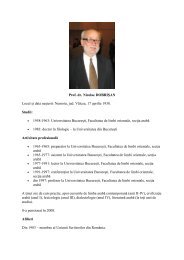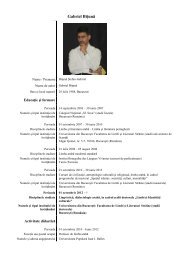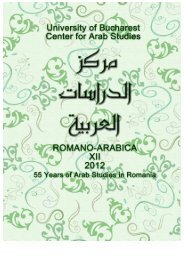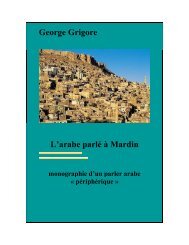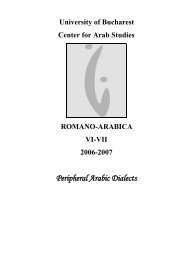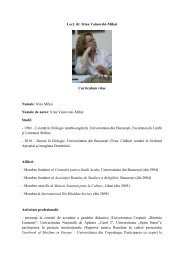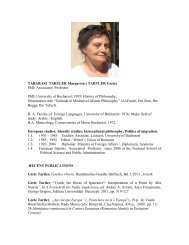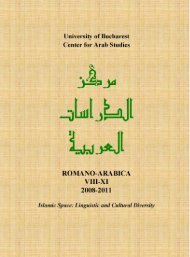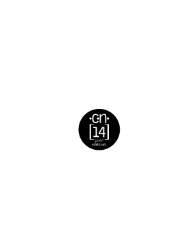- Page 1 and 2: University of Bucharest Center for
- Page 3 and 4: Editor: Nadia ANGHELESCU Associate
- Page 5 and 6: Contents Nadia ANGHELESCU, Le rôle
- Page 7 and 8: Notre exposé se propose de traiter
- Page 9 and 10: hétorique arabe, voir aussi D.E. K
- Page 11 and 12: Les remarques sur la terminologie u
- Page 13 and 14: la métaphore (‟isti„āra), en
- Page 15 and 16: de la dichotomie qui intéresse par
- Page 17 and 18: connaissaient : c‘est la coutume
- Page 19 and 20: qiyām /l‘action/ de ‗se lever
- Page 21 and 22: Notre exposé pose encore une fois
- Page 23: al-Ğurğānī, ‗Abd al-Qāhir.
- Page 27 and 28: The results for the 20 languages co
- Page 29 and 30: 2000: 216). Compare, for instance,
- Page 31 and 32: The occurrence of passive forms in
- Page 33 and 34: (57) ğuá (Prokosch 1986: 64) LH
- Page 35 and 36: writes ―cf Yoruba iloru enu ‗th
- Page 37 and 38: 8. Other substrate languages of JA
- Page 39 and 40: Owens, J. 1990. ‗East African Nub
- Page 41 and 42: The grammarians‘ discussion does
- Page 43 and 44: it is reported to be admissible by
- Page 45 and 46: notably Ibn al-Sarrāğ, Fārisī a
- Page 47 and 48: 2. Conversely, Duraywid is reported
- Page 49 and 50: which some grammarians have accepte
- Page 51 and 52: l-manzilatayni) between kāna and m
- Page 53 and 54: marginal matter not related to the
- Page 55 and 56: 26. Ibn al-Anbārī, Asrār 139. 27
- Page 57 and 58: Ibn al-Anbārī, Ins}āf = Abū l-B
- Page 59 and 60: de voir ce qu'un traducteur ou un a
- Page 61 and 62: min sa„āti-hi wa kāna Allāhu w
- Page 63 and 64: *** 1977. Theological Dictionary of
- Page 65 and 66: ather than certainties that are for
- Page 67 and 68: He also notices the fact that the p
- Page 69 and 70: Irq.: tilzem mayz māl itna„aš n
- Page 71 and 72: Mar.: el-hèddam dyal-ak ―your se
- Page 73 and 74: ut also: Alg.: el-hilāl nta„ eš
- Page 75 and 76:
Irq.: abū hàmsīn ―(a coin of)
- Page 77 and 78:
3.7.5. The idea of quantity, size,
- Page 79 and 80:
they are present in all Arabic dial
- Page 81 and 82:
The following remarks do not aspire
- Page 83 and 84:
with the Life of Saint Paraskevi th
- Page 85 and 86:
eplaced by hā‟: common cardinal
- Page 87 and 88:
seems to have been using a lost ver
- Page 89 and 90:
Other examples I found include ‟a
- Page 91 and 92:
References A. Primary sources: Maca
- Page 93 and 94:
plupart des termes désignant les d
- Page 95 and 96:
commentaires coraniques de la péri
- Page 97 and 98:
immédiatement : « La parole de Di
- Page 99 and 100:
nonévident/caché‘ [litt. : vent
- Page 101 and 102:
institution [linguistique] et cela
- Page 103 and 104:
l‟informe là-dessus, car Dieu l
- Page 105 and 106:
Ces deux énoncés sont des questio
- Page 107 and 108:
effet ce sont les mécroyants qui s
- Page 109 and 110:
confirmer‘ signifie amener l‘al
- Page 111 and 112:
jussif) ». Or chez le kalāmī BDZ
- Page 113 and 114:
conventionnelles de certains actes
- Page 115 and 116:
Zarkašī, Burhān = Badr ad-Dīn M
- Page 117 and 118:
118
- Page 119 and 120:
arabe de Mardin, une situation pare
- Page 121 and 122:
plus, car la lecture du Coran, bien
- Page 123 and 124:
uelles mardiniennes, le turc est tr
- Page 125 and 126:
qu‘accidentellement, dans les mot
- Page 127 and 128:
« Ma mère m'a dit que tu n‘éta
- Page 129 and 130:
KM : birin (prendre) ; keftin (tomb
- Page 131 and 132:
libanais. Dans ce dialecte, la cons
- Page 133 and 134:
séquences plus ou moins étendues
- Page 135 and 136:
Tout d'abord, sa prétention à imp
- Page 137 and 138:
s'ériger en savoir, et surtout en
- Page 139 and 140:
grammaire), elle manifeste une anti
- Page 141 and 142:
point de vue, l'énoncé du grammai
- Page 143 and 144:
contre l'ordre « naturel » d'une
- Page 145 and 146:
s'exclame le grammairien scandalis
- Page 147 and 148:
8. Je signale à ce propos que, dan
- Page 149 and 150:
with the possible exception of spec
- Page 151 and 152:
linguistics? Many of the errors are
- Page 153 and 154:
processing from deep to surface str
- Page 155 and 156:
unpredictable material, but rather
- Page 157 and 158:
―The Classifier,‖ but not *―T
- Page 159 and 160:
culture) is to consider the followi
- Page 161 and 162:
‗canoeing‘ is due to the loanwo
- Page 163 and 164:
ook‘), 80 one Prophet, Muhammad,
- Page 165 and 166:
‗baby trolley (carriage)‘; al
- Page 167 and 168:
which underlies al-barīd, i.e., th
- Page 169 and 170:
4. Maybe the layman has got it righ
- Page 171 and 172:
prominent than verbs because they s
- Page 173 and 174:
31. Beard (1982) proposed that numb
- Page 175 and 176:
49. I owe to James Dickins (p.c.) t
- Page 177 and 178:
1908:527). In my opinion, this woul
- Page 179 and 180:
which explains why it remains terra
- Page 181 and 182:
e.g., lavorare alla posta ‗to wor
- Page 183 and 184:
Pawley, Andrew. 1993. ―A language
- Page 185 and 186:
the negative of ‟in qatala and th
- Page 187 and 188:
(7) wa-‘in yaraw kulla ‘āyatin
- Page 189 and 190:
un seul système en arabe classique
- Page 191 and 192:
contretemps ! », plus exactement
- Page 193 and 194:
La fille rejette l‘interprétatio
- Page 195 and 196:
verbal de l‘arabe classique. L‘
- Page 197 and 198:
Larcher, Pierre. 1994. « Mā fa„
- Page 199 and 200:
describing a situation in which: (a
- Page 201 and 202:
The claim that the causer of a form
- Page 203 and 204:
‗And some times he makes you feel
- Page 205 and 206:
particularize form II causatives in
- Page 207 and 208:
208
- Page 209 and 210:
environnante à sa propre personne.
- Page 211 and 212:
En résumé, le trajet métaphoriqu
- Page 213 and 214:
L‘oeil est une personne exerçant
- Page 215 and 216:
troisième niveau est le radical, c
- Page 217 and 218:
2.3.Qalb. Le nom arabe qalb est le
- Page 219 and 220:
trou », « orifice », « porosit
- Page 221 and 222:
to a disallowed cluster of two quie
- Page 223 and 224:
the pause is intended for istirāh}
- Page 225 and 226:
l-lisān irtifā„atan wāh}idatan
- Page 227 and 228:
when it receives a vowel (li-‟ann
- Page 229 and 230:
The rule given by Ibn Ya‗īš is
- Page 231 and 232:
We have already seen above that acc
- Page 233 and 234:
on the basis of ranking of constrai
- Page 235:
- & Jean-Patrick Guillaume. 1984. E



